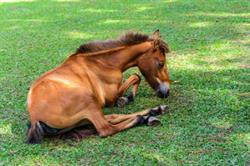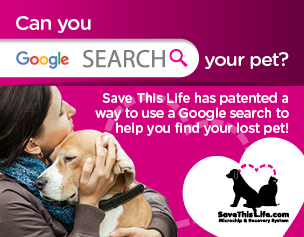Equine Strangles: What Clients Need to Know

Named for the sound caused as it infects the nose and nasopharynx, strangles is an extremely contagious acute upper respiratory disease caused by a Streptococcus equi bacteria.
Transmission
Strangles spreads through direct and/or indirect contact with an infected horse. When direct contact occurs, it is with an animal that:
- Is incubating the disease
- Is a carrier of the disease
- Is in recovering stages of the disease
Horses recovering from strangles may continue to shed the bacteria through their nose and saliva for six weeks following an infection.
Indirect contact occurs through:
- Contaminated stabling area, for example:
- Feed and water buckets
- Staff walls and gates
- Bedding
- Riding and working equipment, such as:
- Grooming tools
- Blankets
- Bridles, halters, saddles
- Trailers
- Pasture environment
- Grass
- Fencing and gates
- Water troughs
- Flies
Clinical Signs
Exposure to the bacterium does not always mean the animal will become infected. When they do, the first clinical signs may include:
- Depression
- Inappetence
- Nasal, and sometimes, eye discharge
- Discharge will start watery, but quickly becomes thick, yellow and purulent
- Dry and painful cough
- Fever of up to 104° Fahrenheit
In cases where the animal is left untreated, the next phase of the illness may involve:
- Swollen, tender lymph nodes based in the submandibular and retropharyngeal area
- Painful swallowing
- An infected animal may stand with his head down and neck stretched out in an effort to relieve the pain.
As the disease continues to progress, the lymph node abscesses may enlarge to become hard and painful to the point that they compress the trachea or pharynx obstructing the animal’s breathing. This is the point in the infection where the disease got its name, “strangles.”
Usually around 7 to 14 days after the onset of the disease, the abscesses will begin to break down, open to the outside, and drain. Once drainage occurs the pain will ease, and the animal will begin to recover.
Diagnosis and Treatment
Strangles is highly contagious. If suspected, it is imperative that clients know to contact their veterinarian to combat its spread. A confirmed diagnosis can be made through observing clinical signs and culturing gathered smears of infected discharges that come from the animal’s:
- Nose
- Lymph node abscesses
- Throat
Once diagnosed, preparations should be made to place the animal in isolation. A quarantine area should provide the horse with:
- A warm, dry stall
- A wet diet
- Fresh water that is available at all times and not shared with any other horse.
There are differing opinions as to the medical treatment of strangles. Penicillin has been shown to be effective in the early stages, but not all agree with its use as the disease advances. Many recommend steps focusing on nursing care instead, such as applying poultices to hasten abscess development and quicken the time to drain infectious material from the body. Abscesses that don’t open on their own should be lanced, drained, and cleaned by a veterinarian.
Vaccinations
Vaccines against strangles are available in both a killed and live version. The decision to use them should be discussed with a veterinarian.
Prevention
Streptococcus equi is a resilient bacteria and can survive for weeks in the environment. In order to prevent its spread, clients should be advised to establish a strict hygiene regimen that focuses on the animal, its surroundings, and those providing its care. Steps to follow should include:
- Isolate and quarantine infected animals
- Kill the bacteria easily by heat and disinfectants such as an iodine-based disinfectant, chlorhexidine, or hot steam spray. Eliminating its spread will require steps such as:
- Cleaning and disinfecting water buckets and feed containers daily
- Scrubbing to disinfect any stall areas contaminated by an infected animal
- Establish procedures for people working with infected animals
- Those working in quarantined areas should wear coveralls and boots
- Clothing should be changed before leaving the area
- Disinfecting wash areas should be set up for use before and after animal contact
- Control flies
- Remove manure and organic material from animal’s staff
- Dispose of material by burning or composting
- Contaminated pasture should be left to rest for a minimum of four weeks
- Animals new to the farm should be quarantined for 2 to 3 weeks
- Establish routines for:
- Temperature checks to watch for fevers
- Nasal swabbing to watch for bacteria
Important Information to Pass on to Client
- Animals that run a higher risk of the disease are ones that:
- Compete and frequently come into contact with other horses
- Come from herds with large, mobile populations
- Clients should be reminded to:
- Encourage the horse to drink as much water as possible
- Clean the nostrils frequently to remove any secretion build-up
- Clients need to know that strangles can be fatal if complications arise; therefore, they should be encouraged to remain in contact with their veterinarian during the animal’s illness and recovery.
If you need more information on equine strangles or other horse illnesses and diseases, please don’t hesitate to contact your Covetrus representative by calling 855.724.3461.
Sources:
http://www.omafra.gov.on.ca/english/livestock/horses/facts/03-037.htm
http://www.thehorse.com/free-reports/29987/strangles


Working Here
Our team members are encouraged to be the best they can be... at Covetrus we believe we impact one another.
Learn MoreNews & Events
FDA Cautions Pet Owners Not to Feed Texas Tripe Inc. Raw Pet Food Due to Salmonella, Listeria Monocytogenes
The U.S. Food and Drug Administration is cautioning pet owners not to feed their pets any of the Texas Tripe brand raw frozen pet food listed below because several samples of Texas Tripe raw pet food have tested positive for Salmonella and/or L. mono.
Careers
Are you looking for a place to let your talents shine? At Covetrus, we help our practitioner customers better serve their patients and take pride in providing the best customer experience possible. Search our open positions to see our available opportunities.
Newsletter
Stay current with what’s going on with Covetrus, subscribe to receive our newsletter and email communications. Subscribers will receive the latest information in practice management, sales and marketing, animal health, and more.



-3-(1).png?sfvrsn=2d806d73_0)

Leave a comment